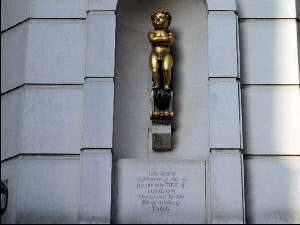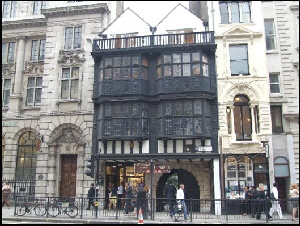I’m sure you know more about the Great Fire of London in 1666 than I do. It’s as much folk lore as it is fact, so I thought I’d have a look at the fire from street level.
This fellow (below) the Golden Boy of Pye Corner, is a quirky sign of how the fire was viewed in its day. Because the fire started in Pudding Lane, and ended at Pye Corner, some blamed it on gluttony and the fire was therefore seen as a message from God himself that Londoners should mend their ways and not be so greedy. This chubby little statue in Giltspur St, leading to Smithfield Garden, is a reminder of that message.
King Charles II himself is credited with rallying the population and organising the defence of London against the flames; because he was one of the few men in London with enough influence to affect a result, and he was the one who acted.
It is possible that the fire more or less killed off the Plague. Probably this was caused by the flames destroying the infrastructure that the fleas which spread the Plague lived in – straw, debris, rats and the food the rats lived on.
This picture is in St Brides Fleet St. It clearly shows how St Pauls dominated London in the early 17th Century. St Pauls was completely destroyed as the lead from its roof ran molten in the streets. You can also see the distinctive spire of St Mary le Bow as it was before the fire.
The Samuel Pepys Exhibition building, below, in Fleet St, opposite Chancery Lane, marks the westernmost extent of the fire. Everything to the left was destroyed; this lovely building remains. They say no-one was killed, because the flames moved quite slowly, but it’s likely that peasants, serfs and villeins didn’t count. If you stand in the middle of the road in front of this building (not for long!) you can see St Pauls on Ludgate Hill to the east. It’s not very far from there to here, so you can see that 17th Century London was not a very big place, but you can also see from the cramped buildings, tiny lanes and narrow footpaths that it was a very compact city, dominated by foot traffic. Immediately after the fire, thatched houses were prohibited. The Globe Theatre in Bankside, built in the 1990s, was the first new thatched building in London since 1666.



